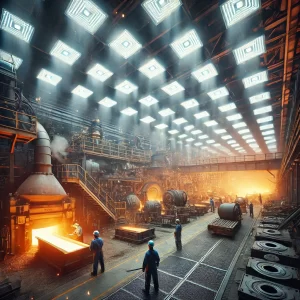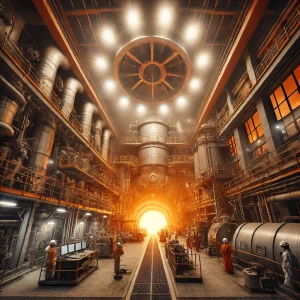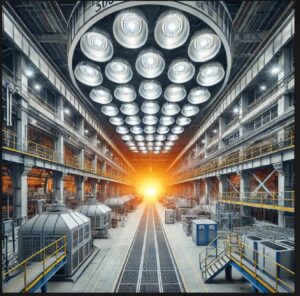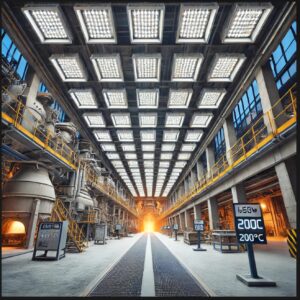I. Introduction
Overview of float glass manufacturing and its high-temperature environment
- Introduction to Float Glass Manufacturing
Float glass manufacturing is the most widely used process for producing high-quality, uniform, and distortion-free flat glass. This method involves floating molten glass on a bed of molten tin, allowing it to spread and form a smooth surface. The process is essential for producing glass used in windows, automotive applications, solar panels, and architectural structures.
- Key Stages of the Float Glass Process
The manufacturing process consists of several high-temperature stages:
- Batch Preparation: Raw materials such as silica sand, soda ash, limestone, and other additives are mixed and fed into the furnace.
- Melting Furnace (1550°C – 1600°C): The raw materials are melted in a large furnace at extremely high temperatures to form molten glass.
- Float Bath (600°C – 1100°C): The molten glass is poured onto a bed of molten tin, where it spreads evenly and forms a perfectly flat surface. The temperature gradually decreases as the glass moves along the bath.
- Annealing Lehr (500°C – 700°C): The glass undergoes controlled cooling to relieve internal stresses and prevent breakage.
- Cutting and Inspection: The cooled glass is cut into sheets, inspected for quality, and prepared for further processing or shipment.
- High-Temperature Challenges in Float Glass Plants
The extreme heat generated during the process presents several challenges, including:
- Heat Exposure: The manufacturing area, particularly near the furnace and float bath, experiences temperatures exceeding 200°C.
- Harsh Environmental Conditions: High-intensity radiant heat, airborne glass dust, and chemical exposure create a demanding working environment.
- Equipment Durability: Conventional lighting systems degrade rapidly under intense heat, leading to frequent failures and high maintenance costs.
- Importance of Reliable Lighting in Float Glass Production
Proper illumination is crucial in glass manufacturing for:
- Worker Safety: High visibility is needed to monitor equipment, detect defects, and ensure safe operations.
- Quality Control: Consistent lighting helps identify imperfections in glass sheets.
- Operational Efficiency: Well-lit environments improve workflow and reduce downtime caused by poor visibility.
Given these factors, specialized high-temperature LED lighting solutions are essential for ensuring reliability and efficiency in float glass manufacturing facilities.

Importance of reliable lighting in extreme heat conditions
(1) Ensuring Worker Safety
In high-temperature environments like float glass manufacturing, worker safety is a top priority. Reliable lighting is essential to:
- Improve visibility in areas near furnaces, molten glass, and float baths, where exposure to extreme heat poses significant risks.
- Reduce accidents caused by poor illumination, such as slips, trips, or mishandling of materials.
- Enable clear identification of emergency exits, pathways, and safety equipment in case of an emergency.
(2) Enhancing Operational Efficiency
Efficient production processes depend on proper lighting for:
- Precision Work: Workers need consistent illumination to accurately monitor the glass-forming process and make necessary adjustments.
- Minimized Downtime: High-quality, heat-resistant LED lighting ensures continuous operation without failures, reducing maintenance-related disruptions.
- Improved Workflow: Bright and uniform lighting supports seamless coordination among workers and enhances overall productivity.
(3) Maintaining Product Quality
- Defect Detection: Inadequate lighting can lead to overlooked imperfections in the glass, resulting in defective products.
- Consistent Inspection: Proper illumination allows operators to detect bubbles, scratches, or distortions early in the process, preventing costly waste.
(4) Reducing Maintenance and Downtime
- Longevity in Extreme Heat: Conventional lights degrade quickly under extreme temperatures, requiring frequent replacements. High-temperature LED lighting is designed to withstand such conditions, significantly reducing maintenance frequency.
- Lower Costs: By using durable, heat-resistant lighting, manufacturers can cut replacement costs and labor expenses associated with constant fixture changes.
(5) Energy Efficiency in Harsh Environments
- Lower Power Consumption: High-temperature LED lights consume significantly less energy compared to traditional incandescent or halogen lights, helping manufacturers reduce operational costs.
- Sustainability: Energy-efficient lighting contributes to lower carbon emissions and supports eco-friendly manufacturing practices.
(6) Compliance with Industry Standards
- Many industries, including glass manufacturing, require compliance with strict safety and lighting regulations. Using reliable, heat-resistant LED solutions ensures adherence to workplace safety standards and enhances overall operational credibility.
Reliable lighting in extreme heat conditions is critical for safety, efficiency, and product quality in float glass manufacturing. High-temperature-resistant LED lighting provides a durable, energy-efficient solution, reducing downtime and ensuring optimal performance in harsh environments.

Challenges faced by traditional lighting solutions in 200°C environments
Challenges Faced by Traditional Lighting Solutions in 200°C Environments
Operating lighting systems in extreme heat conditions, such as those found in float glass manufacturing facilities, presents several significant challenges. Traditional lighting solutions struggle to perform efficiently and safely in temperatures reaching 200°C due to the following limitations:
1. Rapid Degradation and Short Lifespan
- Heat Sensitivity: Conventional lighting technologies like incandescent, halogen, and metal halide lamps have components (filaments, glass enclosures, ballasts) that degrade quickly when exposed to prolonged high temperatures.
- Frequent Failures: The thermal expansion and contraction of materials cause structural weakness, leading to breakage or burnout within a short period.
- Increased Maintenance Costs: Constant replacements and repairs lead to higher labor and equipment costs, reducing overall operational efficiency.
2. Poor Thermal Management
- Overheating Issues: Traditional lighting generates its own heat, which adds to the already high ambient temperature in a 200°C environment, increasing the risk of thermal overload.
- Ineffective Cooling Mechanisms: Most conventional fixtures rely on passive air cooling, which becomes ineffective in extreme heat where natural convection is minimal.
- Failure of Electronic Components: Ballasts and wiring insulation in fluorescent and HID lamps deteriorate under high temperatures, leading to electrical failures and reduced efficiency.
3. Reduced Light Output and Performance
- Diminished Lumen Output: High temperatures cause traditional bulbs to dim over time, leading to inconsistent illumination. This can impact worker visibility and compromise quality control in manufacturing.
- Color Shifting: Some lighting technologies, such as high-intensity discharge (HID) lamps, experience changes in color temperature and spectral output when exposed to extreme heat, affecting visibility and accurate inspection of glass products.
4. High Energy Consumption
- Inefficiency of Heat-Generating Bulbs: Traditional lighting solutions, such as halogen and HID lamps, convert a significant portion of their energy into heat rather than light, making them highly inefficient in an already hot environment.
- Excessive Cooling Requirements: To prevent overheating, manufacturers may need to invest in additional cooling systems, increasing overall energy costs.
5. Safety Hazards
- Risk of Explosion and Fire: Incandescent and halogen lamps operate at very high internal temperatures, making them prone to shattering or even igniting combustible materials in high-temperature environments.
- Glass and Metal Component Failures: The extreme heat weakens glass enclosures and metal housings, increasing the risk of fixture failure and workplace hazards.
Traditional lighting solutions are ill-suited for 200°C environments due to their susceptibility to heat damage, frequent failures, and high energy consumption. To overcome these challenges, manufacturers must adopt high-temperature-resistant LED lighting, which offers superior durability, efficiency, and safety in extreme industrial conditions.

II. Challenges of High-Temperature Lighting in Float Glass Manufacturing
Intense heat exposure and its impact on conventional lighting
Intense Heat Exposure and Its Impact on Conventional Lighting
In high-temperature environments such as float glass manufacturing, where ambient temperatures can reach 200°C, conventional lighting systems face severe operational challenges. Intense heat exposure accelerates degradation, reduces performance, and increases safety risks, making traditional lighting solutions ineffective in such conditions.
1. Accelerated Material Degradation
- Filament Burnout: Incandescent and halogen lamps rely on delicate filaments that become brittle and break under extreme heat, drastically reducing their lifespan.
- Glass Weakening and Shattering: High temperatures cause expansion and contraction in glass enclosures, leading to cracks, structural weakness, and eventual shattering.
- Ballast and Capacitor Failure: Fluorescent and HID lamps depend on electronic components that degrade under prolonged heat exposure, leading to power instability and frequent replacements.
2. Diminished Light Output and Efficiency
- Lumen Depreciation: High temperatures accelerate phosphor degradation in fluorescent lamps and cause metal halide bulbs to lose brightness, resulting in reduced visibility.
- Color Temperature Shifts: Prolonged exposure to extreme heat alters the spectral output of HID lamps, affecting visibility and making quality inspections less reliable in manufacturing environments.
- Increased Energy Consumption: Heat exposure reduces electrical efficiency, causing conventional lights to draw more power while delivering lower illumination levels.
3. Overheating and Thermal Runaway
- Ineffective Cooling Mechanisms: Conventional lighting technologies lack advanced thermal management systems, leading to overheating and performance degradation.
- Excessive Heat Build-Up: Incandescent and HID lamps generate their own heat, compounding the high ambient temperatures and increasing the risk of fixture failure.
- Thermal Runaway Effect: Continuous exposure to extreme heat can create a self-perpetuating cycle where rising temperatures accelerate internal component breakdown, leading to premature burnout.
4. Increased Maintenance and Replacement Costs
- Frequent Failures: The inability of conventional lighting to withstand high temperatures results in continuous replacements, increasing operational costs.
- Downtime for Repairs: Replacing failed fixtures in an industrial setting disrupts production and poses safety risks to maintenance personnel working near high-temperature areas.
- Higher Cooling Requirements: Additional ventilation or cooling systems may be required to counteract lighting-induced heat, further adding to energy costs.
5. Safety Risks and Hazards
- Explosion and Fire Hazards: Halogen and HID lamps operate at high internal temperatures, making them prone to bursting or igniting surrounding materials.
- Electrical Failures: Heat-induced insulation breakdown in wiring and ballasts can lead to electrical short circuits, posing fire and safety hazards.
- Glass Fragmentation: In extreme cases, glass enclosures of conventional lamps can shatter due to rapid temperature fluctuations, creating dangerous workplace conditions.
Intense heat exposure significantly compromises the performance, longevity, and safety of conventional lighting solutions. In environments reaching 200°C, high-temperature-resistant LED lighting provides a more durable, energy-efficient, and safer alternative, ensuring reliable illumination in extreme industrial conditions.

Risks of frequent failures, short lifespan, and high maintenance costs
Risks of Frequent Failures, Short Lifespan, and High Maintenance Costs
In high-temperature environments like float glass manufacturing, conventional lighting systems face severe challenges due to extreme heat exposure. Frequent failures, short operational lifespans, and increased maintenance demands create significant risks that impact safety, productivity, and operational costs.
1. Frequent Failures Due to Heat Stress
- Component Breakdown: Traditional lighting systems, including incandescent, halogen, and HID lamps, contain fragile components such as filaments, ballasts, and glass enclosures that degrade rapidly under extreme temperatures.
- Thermal Expansion and Contraction: Constant exposure to high heat causes materials to expand and contract, leading to cracks, loose connections, and eventual fixture failure.
- Overheating and Meltdowns: Conventional lamps generate additional heat during operation, compounding the problem and accelerating their degradation in already high-temperature environments.
2. Short Lifespan Leading to Operational Disruptions
- Rapid Deterioration: Traditional bulbs have a limited lifespan, which is further shortened when exposed to prolonged high heat. For example, standard metal halide lamps, which typically last 10,000–20,000 hours, may experience drastic reductions in longevity in extreme conditions.
- Premature Burnouts: High heat weakens phosphor coatings in fluorescent and HID lamps, causing lumen depreciation and early failure.
- Unplanned Replacements: Frequent lighting failures disrupt production schedules, requiring frequent replacements that increase downtime and reduce operational efficiency.
3. High Maintenance Costs and Increased Downtime
- Frequent Replacements: Due to their inability to withstand extreme temperatures, traditional lighting fixtures require constant maintenance, increasing labor and material costs.
- Difficult Access for Repairs: In industrial facilities, lighting fixtures are often installed in hard-to-reach areas near furnaces and high-temperature zones, making replacements dangerous, time-consuming, and costly.
- Additional Cooling Requirements: To mitigate overheating, manufacturers may need to invest in extra ventilation or cooling solutions, further raising energy consumption and expenses.
4. Safety Risks Associated with Lighting Failures
- Sudden Blackouts and Visibility Issues: Unexpected failures in critical production areas can lead to workplace accidents and compromise quality control.
- Glass Shattering and Fire Hazards: Overheated bulbs may explode or ignite combustible materials, increasing the risk of workplace injuries.
(To Be Continued)



